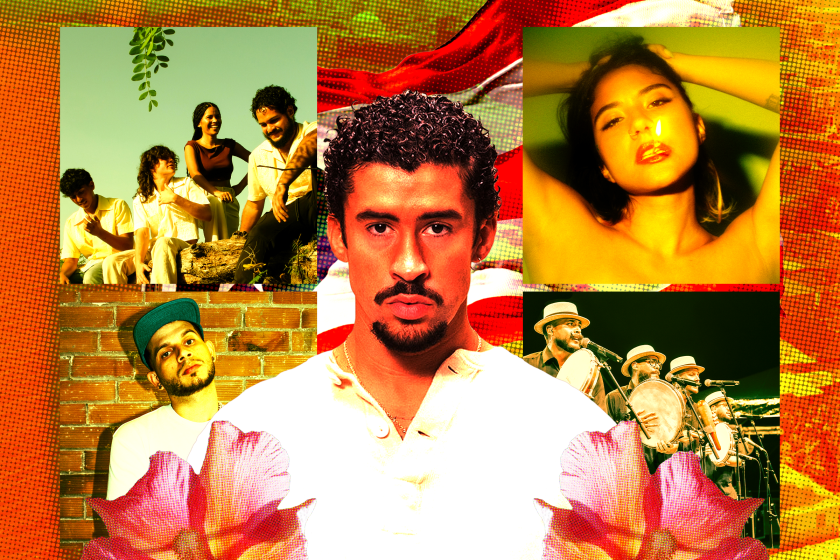Cyndi Lauper sees herself in Billie Eilish and Lizzo: They’re ‘not about being an object’
- Share via
For the record, no — Cyndi Lauper and Marilyn Manson have not secretly been hanging out this whole time.
Though the two singers are set to perform Manson’s “The Beautiful People” together this week in Los Angeles, they hadn’t actually met yet as Lauper sipped a hemp-milk matcha latte the other afternoon at the Sunset Marquis. But, she was quick to clarify, she’s definitely a big fan of the veteran goth-rock star with whom she was due to rehearse the next day.
“I love that creepy thing he’s got going on,” said the ’80s pop icon. “And his version of ‘Sweet Dreams’? Come on!”
Lauper and Manson’s duet is just one of the many wacky team-ups in store for the latest edition of Lauper’s annual Home for the Holidays concert. Typically held in the singer’s hometown of New York, the show — a fundraiser for her True Colors United organization, which helps fight homelessness among young LGBTQ people — has moved for the first time this year to L.A.’s Novo club, where Lauper, 66, will be joined Tuesday night by a diverse cast of pals and admirers including Kesha, Brandi Carlile, King Princess, Henry Rollins (with whom she’ll sing Black Flag’s “Rise Above”), the Offspring’s Dexter Holland, Belinda Carlisle of the Go-Go’s, Lily Tomlin, Margaret Cho and Billy Porter, who originated the role of Lola in Lauper and Harvey Fierstein’s Tony-winning Broadway musical “Kinky Boots.”
“We just figured maybe we’d exhausted everyone in New York, so why not come here?” she said. “Plus: better Mexican food.”
New location aside, the concert’s all-over-the-place lineup is in keeping with an eclectic solo career that began nearly 40 years ago, when Lauper’s smash debut, 1983’s “She’s So Unusual,” introduced a squeaky-voiced singer capable of bridging pop, new wave and R&B. More recently, she’s tried blues (on 2010’s “Memphis Blues”) and country (2016’s “Detour”), and currently she’s at work on another musical, this one based on the 1988 film “Working Girl.” These are excerpts from our conversation.
Did you ever have a move-to-L.A. moment in the ’80s?
No, but I spent a long time out here on the “Goonies” video. Stayed at the old Shangri-La hotel in Santa Monica, which back then was kind of beat-up and nice at the same time — perfect for me. But I was lonely. I had some friends, but L.A. was a little clique-ish.

Do cliques intimidate you? For your blues album, you hired players who’d been deep inside the Memphis scene for ages.
That was tricky because I was white, and the last thing I wanted to do was a Pat Boone number. The drummer [Howard Grimes], he came in and he goes, “My granddaughter says you have a song — ‘Girls Just Want to Have Something.’ ” I said, “Yeah, but we’re doing this now.”
What about the Nashville players on your country album?
Totally different. They didn’t give a s— who was singing. Maybe they didn’t mean it; it’s a little sexist down there.
Why is it so easy for you to find common ground?
When I was a kid, music wasn’t in a compartment. It all went together seamlessly: James Brown and Otis Redding and the Beatles and Joni Mitchell and “In-a-Gadda-Da-Vida.” It was pop music. Then the ’80s happened: “This is pop — but, oh wait, that’s R&B.” God bless Michael Jackson, who broke the color barrier. Then, he got that disease that gave him white spots. And he never said anything. He went to the doctor and they said they couldn’t put the color back in but they could bleach his skin. So that’s what they did, and then everybody was like, “Oh, he just wants to be white.” He had a skin condition, you idiots!
Your philanthropic work requires you to schmooze rich people and corporate types.
Yes, it does. I sell myself. I sell whatever I have to for these kids without a home.
Is that a natural role for you?
No, but I’m trying. I’m still a person from the neighborhood with a chip on my shoulder: “Go ahead, knock it off.” But for instance with “Kinky Boots,” I met Daryl Roth; she’s one of the producers that saw the film in the first place and thought it would make a great musical. She called Jerry Mitchell, the director, and he called Harvey Wein— Fierstein. Harvey Fierstein.
Not Harvey Weinstein.
Poor Harvey Fierstein. He was getting all these crazy things on email and Twitter, and he was writing back, “It’s not me! I’m the fabulous Harvey!”
Grammy nominations just came out, and like you in 1985, Billie Eilish and Lizzo were both nominated in all four big categories.
I won one [for best new artist], and I felt lucky. I was the little engine that could. My little video [for “Girls Just Want to Have Fun”] cost $38,000. I opened up my closet to people — that was wardrobe. And the eyeglasses were mine. Lot of friends, lot of community. I just wanted to show a little diversity on MTV, which didn’t have much. I thought, let’s show the neighborhood as it really is.

You were also presenting a different image of femininity.
There was a lot of symbolism in it. I put the chain around my ankle because we weren’t free — and we’re still not free. I’m working on “Working Girl” because everything that was going on in business in 1988 is still going on today. Not a lot has changed, ladies.
How did it feel to be sexualized by the music industry?
Sucked. I was known as a big pain in the ass because I wouldn’t just go along with everything. But I wasn’t interested in just having a hit song; I wanted a hit song that made people feel good. That’s why I love Lizzo and Billie Eilish. When I first heard Lizzo, I started to giggle — it was like a girlfriend. And there’s something about Billie that reminds me of myself in 1983 — something in her performance. And her hair. It’s not about being an object. At this point in my life, yeah, I dress a little sexy. But that’s because we’re not supposed to be sexy at this age. But I’m not gonna dress like Mother Cabrini. I’m not a monk.
How well do you remember recording “We Are the World”?
What I remember very clearly is that they had problems with my jewelry. I’d come straight from the American Music Awards, and so my outfit was direct from stage. And I was so worried about singing well that I didn’t realize I was jangling all over the place.

Did you feel like a kid in the room?
Oh, yeah. Plus, I was so tired and loony that I started telling jokes — bad jokes that weren’t funny. I walk over to say hello to Bob Dylan and Bob Dylan starts walking backwards. All those older rockers, they were afraid of me; they thought I was contagious. But I remember Al Jarreau, how funny he was. He kept saying, “Oh, Cyn — Stevie Wonder’s trying to show Dylan how to sing it.”
Your vocal part is a key emotional moment.
They wanted me to lift the song up. So I’m watching these incredible icons — Diana Ross, Michael Jackson, Bruce Springsteen, Tina Turner — and then it comes around to me. All of a sudden I just close my eyes and I feel my feet go into the ground and my head shoot up, and that’s what came out.
Your famous ad-lib: “Well, well, well, well!”
It’s actually “Well, well, well / Let us realize.” What can I say? I was lucky I got the bridge.
More to Read
The biggest entertainment stories
Get our big stories about Hollywood, film, television, music, arts, culture and more right in your inbox as soon as they publish.
You may occasionally receive promotional content from the Los Angeles Times.











